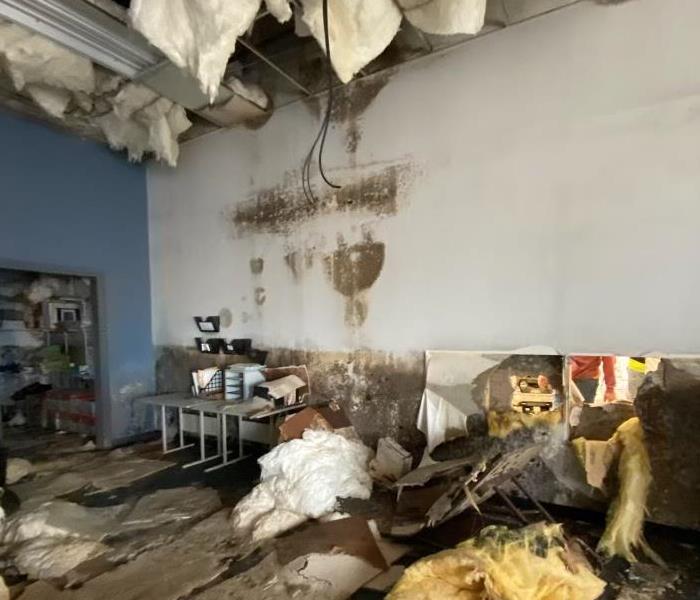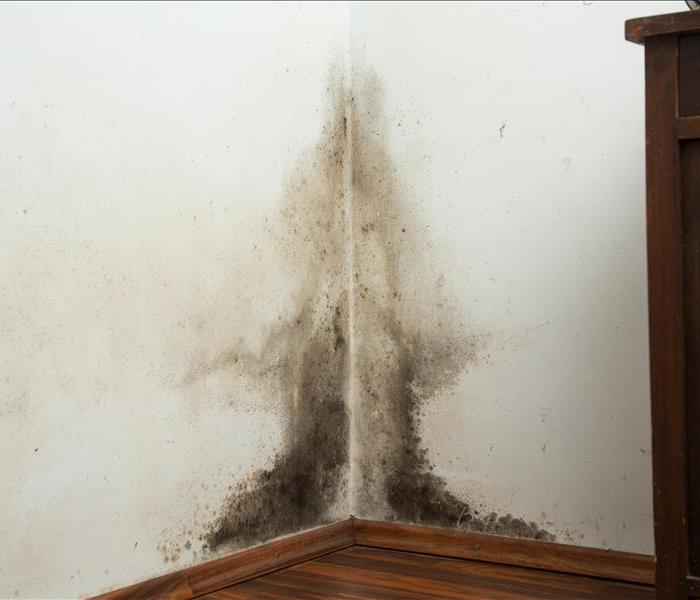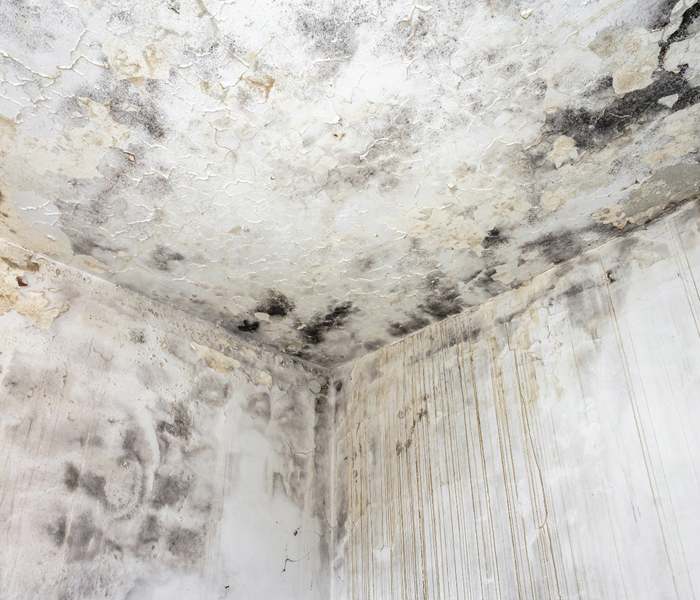Recent Mold Remediation Posts
Spotting Black Mold: 3 Warning Signs and Effective Removal Methods
3/14/2024 (Permalink)
 Recognizing the signs of black mold early is crucial for swift and effective remediation.
Recognizing the signs of black mold early is crucial for swift and effective remediation.
Black mold, scientifically known as Stachybotrys chartarum, is a type of mold that can compromise indoor air quality and cause extensive damage to your property. Recognizing the signs of black mold early is crucial for swift and effective remediation. In this blog, we'll explore three key warning signs of black mold and share practical steps on how to get rid of it.
Signs of Black Mold
Distinctive Appearance:
Black mold often appears greenish-black and has a slimy or powdery texture. While its name suggests a specific color, it can also manifest in dark green or gray hues. It tends to grow in clusters and may spread quickly if left unchecked.
Musty Odor:
Black mold produces a distinct musty odor that can permeate indoor spaces. If you notice an unpleasant, earthy smell, particularly in areas prone to dampness or water damage, it could be an indicator of black mold presence.
Visual Clues:
Inspect surfaces for visual clues such as dark stains, discoloration, or mold growth. Check hidden and less frequently visited areas, as black mold often thrives in damp and poorly ventilated spaces.
How to Get Rid of Black Mold
1. Identify and Address Water Source:
Black mold thrives in damp environments, so the first step is to identify and address any water sources contributing to the mold growth. Fix leaks, repair water-damaged areas, and ensure proper ventilation to reduce moisture levels.
2. Protective Gear and Ventilation:
Before starting the cleaning process, equip yourself with protective gear, including a mask, gloves, and goggles. Open windows and doors to enhance ventilation during the cleaning process.
3. Clean with Mold-Killing Solutions:
Use mold-killing solutions such as commercial mold removers to clean affected surfaces. Scrub the mold off hard surfaces and remove porous materials like drywall or insulation if extensively contaminated.
4. Thorough Drying:
After cleaning, ensure thorough drying of the affected areas. Dehumidifiers and fans can help accelerate the drying process, reducing the likelihood of future mold growth.
5. Regular Inspections:
Regularly inspect your home for signs of moisture and promptly address any water-related issues. Conduct routine checks in areas prone to dampness, such as basements, bathrooms, and attics.
Professional Assistance
While tackling small-scale black mold issues may be feasible for homeowners, larger infestations or widespread contamination may require professional intervention. SERVPRO® experts have the knowledge, experience, and specialized equipment to assess, remediate, and ensure the complete removal of black mold.
In conclusion, early detection and proactive measures are key to addressing black mold. By staying vigilant and implementing effective cleaning methods, you can create a better living environment for you and your loved ones.
How Does Mold Grow in HVAC Systems?
10/24/2023 (Permalink)
 If your facing mold in your HVAC, contact a professional to prevent secondary damage.
If your facing mold in your HVAC, contact a professional to prevent secondary damage.
In this blog post, we'll explore an important topic that homeowners should be aware of: how mold can grow in HVAC (Heating, Ventilation, and Air Conditioning) systems. Understanding the factors that contribute to mold growth in HVAC systems is the first step in preventing this common issue.
Understanding HVAC Systems
HVAC systems are designed to regulate indoor temperature and air quality. While they play a crucial role in keeping your home comfortable, they can also become a breeding ground for mold under certain conditions.
How Does Mold Develop in HVAC Systems?
Moisture is the primary catalyst for mold growth, and HVAC systems can provide a conducive environment. When humidity levels are high, or if there's a leak or condensation within the system, moisture can accumulate.
HVAC systems have air filters that trap dust and debris. Over time, these filters can become clogged, creating a damp surface where mold spores can settle and thrive. Neglecting regular HVAC system maintenance can lead to mold problems. Dirty coils, ducts, and air handlers can provide the organic material and moisture necessary for mold growth. Inadequate ventilation in your home can also contribute to stagnant air within the HVAC system, which can create an ideal environment for mold growth.
How to Prevent Mold Growth in HVAC Systems
Schedule annual HVAC system inspections and maintenance to ensure that all components are clean and functioning properly. This includes cleaning coils, ducts, and changing air filters.
Keep indoor humidity levels below 50% to discourage mold growth. Use a hygrometer to measure humidity and consider using a dehumidifier if necessary. It is also important to replace air filters regularly, following the manufacturer's recommendations. This will not only improve air quality but also reduce the risk of mold growth. Lastly, ensure that your home has adequate ventilation to keep air circulating and prevent stagnant conditions within the HVAC system.
Mold growth in HVAC systems is a common concern for homeowners, but with proper maintenance and attention to humidity levels, it can be prevented. Regular HVAC system inspections and a focus on controlling moisture are key to keeping your HVAC system mold-free.
If you suspect mold growth in your HVAC system or are facing mold issues in your home, don't hesitate to contact SERVPRO® of Northeast Tucson, Oro Valley/Marana East for professional mold remediation and cleanup services. Our experienced team is ready to help you maintain a safe and comfortable living environment.
Rainy Days and Mold Growth: Understanding Why Your Home is at Risk and How to Prevent It
5/16/2023 (Permalink)
 To prevent mold growth, it’s important to regulate the humidity levels in your home.
To prevent mold growth, it’s important to regulate the humidity levels in your home.
Have you noticed mold growth in your home after it rains? You’re not alone. Many homeowners experience mold growth during periods of heavy rain or high humidity. In this blog, we’ll explore the reasons why mold grows in your house when it rains and what you can do to prevent it.
High Humidity Levels
One of the main reasons why you may find mold in your house when it rains is due to high humidity levels. When it rains, moisture levels in the air increase, which can cause humidity levels in your home to rise as well.
If your home has poor ventilation or insulation, the increased humidity can create the perfect environment for mold growth. To prevent mold growth, consider investing in a dehumidifier to regulate the humidity levels in your home.
Leaky Roofs and Windows
Another reason why mold may grow in your home when it rains is due to leaky roofs or windows. If your roof or windows are damaged, rainwater can seep into your home and create damp areas where mold can grow.
To prevent mold growth, it’s important to inspect your roof and windows regularly for any signs of damage. If you notice any leaks, be sure to repair them as soon as possible to prevent water from entering your home.
Poor Drainage
Poor drainage can also contribute to mold growth in your home when it rains. If your gutters and downspouts are clogged or damaged, rainwater can accumulate around your home’s foundation, creating damp areas where mold can grow.
To prevent mold growth, it’s important to keep your gutters and downspouts clean and free of debris. You can also consider installing a drainage system around your home’s foundation to prevent water from accumulating.
Improper Ventilation
Improper ventilation can also contribute to mold growth in your home when it rains. If your home has poor ventilation, moisture can become trapped inside, creating the ideal environment for mold growth.
To prevent mold growth, consider installing exhaust fans in your bathrooms and kitchen to vent moisture outside. You can also open windows and doors on dry days to increase ventilation and reduce humidity levels.
In conclusion, mold growth in your home during periods of heavy rain or high humidity is a common problem for many homeowners. To prevent mold growth, it’s important to regulate the humidity levels in your home, inspect your roof and windows regularly for any signs of damage, keep your gutters and downspouts clean and free of debris, and increase ventilation in your home. Remember, preventing mold growth is crucial in maintaining a healthy and comfortable home environment.

 24/7 Emergency Service
24/7 Emergency Service


